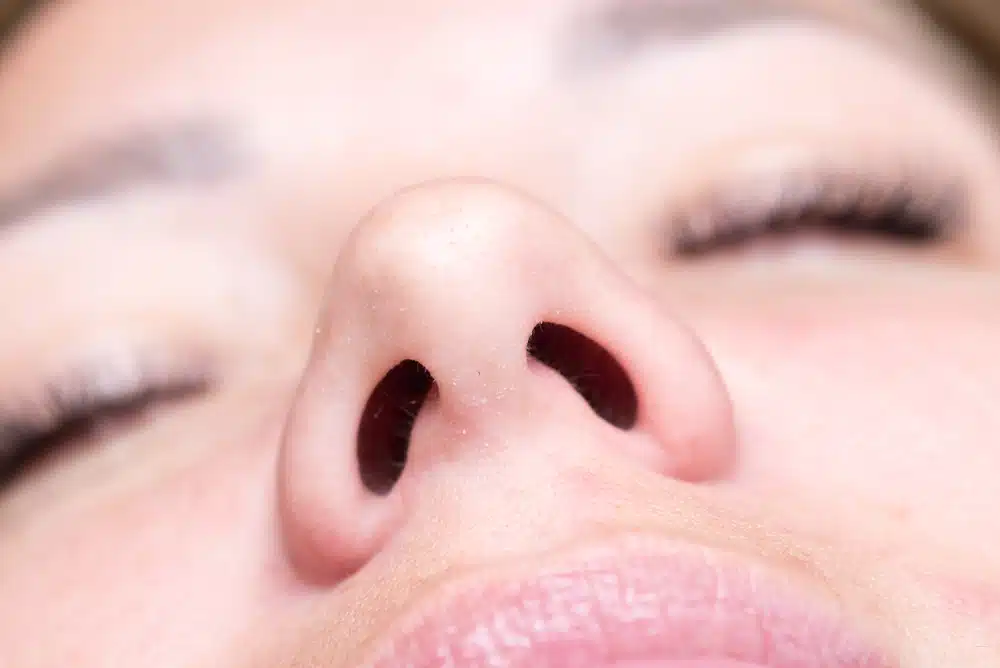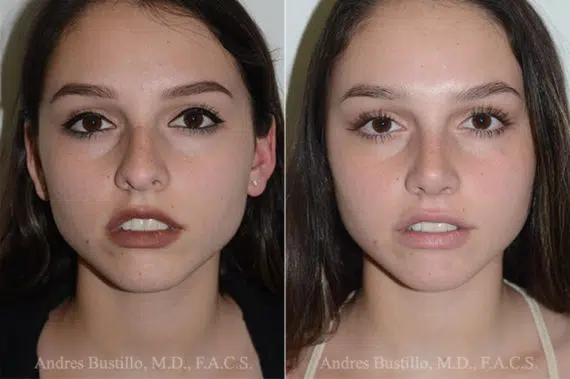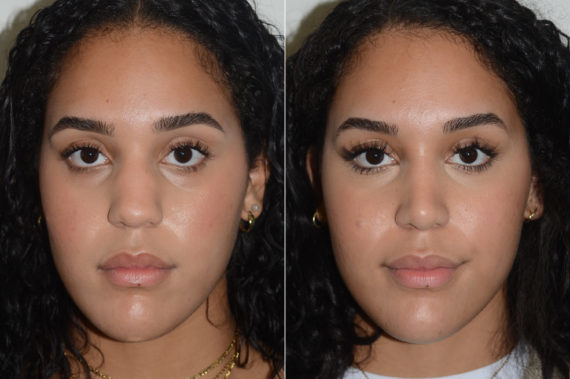Getting a nose job, or rhinoplasty, is a way to change how your nose looks. However, one potential outcome of this procedure is scar tissue after rhinoplasty, which forms as part of the body’s natural healing process. While scarring can be challenging to address once it develops, the good news is that there are effective steps you can take during recovery to minimize its impact and achieve smoother results.
Following your doctor’s advice closely and taking good care of yourself throughout recovery can help you lower your chance of scar tissue development and guarantee a positive result from your rhinoplasty plastic surgery.

1. Understanding How Scar Tissue Forms

How long does it take for Post-rhinoplasty scars to form?
Scar tissue forms as part of the body’s natural healing process after rhinoplasty surgery. When soft tissues are disrupted during surgery, collagen fibers in the area thicken and intertwine, forming a protective network. This process is essential for wound healing, but excessive scar tissue can sometimes affect the nose’s appearance or cause discomfort.
Is Scar Tissue After Rhinoplasty Common?
Yes, scar tissue is a natural part of healing after rhinoplasty procedure. While most patients experience minimal scarring, the degree can vary based on factors such as skin type, the complexity of the procedure, and the surgeon’s technique. An experienced surgeon will aim to minimize visible scars and ensure they heal properly, helping achieve a natural-looking result.
Factors Influencing Scar Tissue Formation:
What Does Excessive Scar Tissue Look Like?
Excessive scar tissue, or hypertrophic scarring, often appears raised, reddish, and firm. It can feel rubbery and may cause slight changes in the nose’s shape, particularly around the tip or incision areas. This is more likely if multiple layers of scar tissue develop. While most scars dissolve gradually, abnormal scarring may require follow-up treatments such as steroid injections or revision surgery to correct it.
Key Insight: Not all scars are the same. Scars can range from barely noticeable to more visible or raised, depending on individual healing and surgical precision. An experienced surgeon plays a crucial role in minimizing and managing scar tissue during both the initial procedure and follow-up consultations.
2. Why Does Scar Tissue Affect Rhinoplasty?
Excessive scar tissue after rhinoplasty can affect both the appearance and structural integrity of the nose. The thickness of scar tissue in such a small area can make it challenging to achieve the desired aesthetic outcome. Additionally, internal scar adhesions may alter the nasal shape over time or even impact breathing.
Expert Tip: Choosing a rhinoplasty expert skilled in both primary and revision procedures can ensure better control over scar formation and long-lasting rhinoplasty results.
3. How To Prevent Scar Tissue After Rhinoplasty
Minimizing scar tissue starts with proper postoperative care. Adopting the following practices can promote healing and reduce scarring:

Additional Tips for Scar Reduction:
- Massage the nose gently with a moisturizer or oil after receiving your surgeon’s approval.
- Protect the surgical area from sun exposure with high-SPF sunscreen or hats.
- Stay hydrated and include vitamins A, C, and E in your diet to support connective tissue development.
4. Post-Surgical Care to Reduce Scarring
While pre-operative recommendations might help to lower the likelihood of further scarring, post-operative recommendations can also be quite helpful. Once the patient returns home, a licensed physician will provide specific guidelines for safe healing comprising:
- Avoid infection and reduce the scarring risk by not touching the nose for at least two weeks after surgery.
- Use a cold compress on your nose several times a day to relieve congestion and inflammation.
- Steer clear of strong chemicals or fragrances; keep the area dry and clean with mild cleansers.
- Eat a well-balanced diet strong in vitamins A, C, and E to promote proper connective tissue development.
- Massage the soft tissue around the nose with a moisturizer or oil to help break up any possible scar tissue growth.
See your surgeon often for check-ups to monitor progress and see any early signs of excessive scarring, thereby allowing consideration of revision surgery if necessary.
Questions about your procedure?
Schedule a consultation with Dr. Andres Bustillo.
5. Is There Any Way To Reduce The Appearance Of My Nasal Scar Tissue?
Scar tissue formation is a natural part of the healing process following rhinoplasty. However, there are several steps you can take to minimize its development and ensure optimal healing.
1. Follow Postoperative Instructions
It is crucial to adhere to your surgeon’s postoperative care guidelines, which are designed to promote healing and prevent complications.
2. Use Topical Treatments
Applying silicone gel or sheets can help minimize the appearance of scars. These products keep the scar tissue hydrated and reduce its thickness and redness.
3. Gentle Massage
Massaging the nasal area can help break down scar tissue and improve circulation. Start this only after your surgeon gives the go-ahead, typically a few weeks post-surgery.
4. Stay Hydrated and Maintain a Healthy Diet
Proper hydration and nutrition support the body’s healing processes.
5. Avoid Sun Exposure
Protect the healing skin from sun exposure, which can darken scars and make them more noticeable.
6. Regular Follow-Up Appointments
Attend all scheduled follow-up appointments with your surgeon to monitor healing and address any concerns promptly.
Types of Scar Tissue After Rhinoplasty
There are different types of scar tissue that can form after rhinoplasty, each with its own characteristics and implications for recovery and final results:
Normal Scar Tissue:
This type of scar tissue forms as part of the normal healing process. It typically settles over time and does not significantly impact the appearance or function of the nose.
Hypertrophic Scars:
These raised and red scars remain within the boundaries of the original incision. They may cause discomfort or tightness but often improve with time or minor treatments.
Keloid Scars:
Keloids extend beyond the original incision and can be more problematic. They are raised firm and can cause both cosmetic and functional issues. Keloids are less common on the nose but can occur in susceptible individuals.
Adhesions:
Internal scar tissue that forms between nasal structures can affect breathing and the shape of the nose. Adhesions may require surgical intervention to correct.
Additional Ways to Manage Scar Tissue After Rhinoplasty
Proper management of scar tissue is crucial to ensure optimal results from rhinoplasty. Here are some strategies:

Choosing a Rhinoplasty Surgeon
Scar tissue is only one of the challenges faced by plastic surgeons during rhinoplasty, so it’s very important that you choose a surgeon who knows what they’re doing. Choosing a surgeon who is board-certified and specializes in rhinoplasty, with a great deal of experience in both primary and revision rhinoplasty, will be your best option.
Dr. Andres Bustillo is a board-certified facial and reconstructive plastic surgeon who has been practicing cosmetic surgery for over ten years. Nasal surgeries, such as rhinoplasty and revision rhinoplasty, make up the majority of his practice.
Dr. Bustillo sees rhinoplasty and revision rhinoplasty patients from all over the world and is known as one of the best facial plastic surgeons in Florida. His conservative approach allows him to give his patients a quality experience and amazing, natural-looking results without overdoing the surgery.
If you are interested in scheduling a rhinoplasty patient consultation with Dr. Bustillo, call his office in Coral Gables, FL, at (305) 663-3380 or send a message through his Contact page.
FAQs About Scar Tissue After Rhinoplasty
Scar tissue is a natural part of the healing process that occurs when the body repairs itself after surgery. During rhinoplasty, incisions are made in the nasal tissue, prompting the body to produce collagen to heal the wound. This collagen forms scar tissue, which can sometimes become excessive or problematic.
To minimize scar tissue formation, follow your surgeon’s postoperative care instructions carefully. This includes keeping the surgical site clean, avoiding strenuous activities, using silicone gel or sheets, and attending all follow-up appointments. Gentle massage and good hydration can also help.
Massaging your nose can help break down scar tissue, but it’s important to wait until your surgeon gives you the go-ahead, usually a few weeks after surgery. Use gentle, circular motions with your fingertips and follow your surgeon’s specific instructions on technique and duration.
Yes, there are several treatments available to reduce the appearance of scar tissue. These include:
Steroid Injections: These can help flatten hypertrophic or keloid scars by reducing inflammation.
Laser Therapy: This can improve the texture and appearance of scars by promoting collagen remodeling.
Topical Treatments: Silicone gels and sheets can help keep scars hydrated and minimize their appearance.
If you notice that your scar tissue is becoming problematic, such as causing discomfort or affecting the appearance of your nose, contact your surgeon. They may recommend treatments such as steroid injections, laser therapy, or, in some cases, surgical revision to correct the issue.
Scar tissue can take several months to years to mature and remodel fully. During this time, the scar may become less dense and more flexible. It’s important to be patient and follow your surgeon’s advice throughout the healing process.
Yes, excessive scar tissue can affect the final appearance and function of your nose after rhinoplasty. This is why it’s important to manage scar tissue formation through proper postoperative care and seek treatment if necessary. Regular follow-up with your surgeon can help ensure any issues are addressed promptly.
Some internal scar tissue is normal and expected after rhinoplasty. However, if you experience significant discomfort or breathing difficulties or notice any unusual changes, it’s important to consult with your surgeon. They can evaluate your condition and recommend appropriate treatments if needed.
Normal healing will involve some swelling and firmness around the surgical site, which should gradually improve over time. Problematic scar tissue, such as hypertrophic scars or keloids, may appear raised and red and cause discomfort. If you’re unsure, it’s best to consult with your surgeon for an evaluation.




